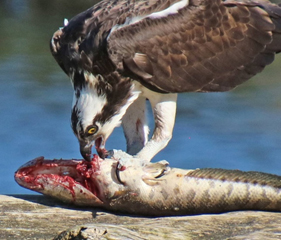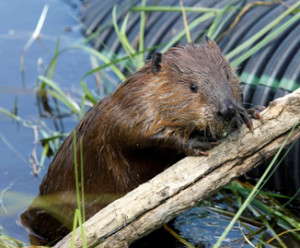The long, sad degradation of the Chesapeake Bay region
Beach walking in my community along Fishing Creek and the Chesapeake Bay always brings me delight in the natural world. My binoculars ever handy, I search for familiar species and sites, always hopeful of surprises. Each season holds its own treasures and this time of summer brings abundant osprey sightings along with purple martins and barn swallows.
Bald eagles can be seen on my walks but are never a sure thing. Recently, cownose rays, found in waters from New England to Brazil, were spotted thrashing on the surface as it is their peak mating season. The tips of their finned wings used for propulsion are often mistaken for sharks, and I witnessed why.
Then there are the large ships anchored and biding their time before their cargo is loaded or unloaded in the port of Baltimore. Due to the supply chain slowdown, 13 are spotted on some days. Crab boats loudly putter about as do a few pleasure craft.
As the warming waters lap the shoreline, a calm comes over me and I give thanks for the wonders of nature and the special place in which I live. I dream of the Chesapeake Bay of my childhood and deeper still that of my watermen ancestors. Then, sadness engulfs me. The sobering realization of the decline of the Chesapeake and its living critters smacks me.
Everywhere I look, I see signs of human-induced degradation. There are the dead blue catfish I now find on the beach, an invasive species recently proliferating in our waters and potentially wreaking havoc upon native species. They join snakeheads and many other invasives foisted on the natural system by humans.
These invaders include free-roaming domestic cats killing as many as 20 billion birds and small mammals in the U.S. each year. European starlings and house sparrows also are problems, the former being the most numerous birds in America. These species displace native species already in serious declines. I see the sparrows occupying some of the bird house rooms reserved on our beach for mosquito-eating purple martins. The martins are aerial insectivores in decline partially linked to these invasive birds.
Mute swans and nutria had been destroying native bay grasses and impacting native species including waterfowl until lethally controlled. I see phragmites, an invasive, hard-to-remove marsh grass that squeezes out native plants, everywhere along disturbed shorelines.
Then there are the resident Canada geese and mallards that are native but have been bred by humans for hunting. Losing their migratory instincts, they have multiplied and stay year-round in the bay region. People love to feed them, worsening the situation as they can displace migratory waterfowl and compete for grasses.
Our Oyster Harbor beach and others close by where I walk are full of gooey green goose poop that has caused our beach to be rated in the past the most unsafe for human contact in the county. I soberly watched a 40-bird goose flotilla cruise our waters when there should be none.
On Tuesday, a young doe jumped a fence in broad daylight to dine on my wife’s flowers. My wife chased the deer off while neighbors laughed, knowing of the damage they, too, have been experiencing. White-tailed deer are native species and beautiful animals, but humans have caused a population explosion with dire consequences. Eliminating predators such as wolves, bears, and mountain lions and then creating perfect suburban habitat has led to deer numbers exceeding carrying capacity. The result: high incidences of Lyme disease; many deer-car accidents; destruction of new growth in forests; and depredation on ornamentals and farm crops.
I find plastic of every kind – bags, bottles, balloons – everywhere on our beaches. I pick up as much as my back and bucket allow, realizing that every day it would take a clean-up crew to remove such litter that can be deadly for marine creatures including sea turtles and birds suffocating on plastic bags.
Exacerbating this growing problem in our throwaway society is the disintegration of plastic products into microplastic as these tiny forever chemicals are now found in every area of the bay and its rivers. Plastic production and disposal increased 200-fold globally over the past 60 years. More than 60% of all seabirds have ingested plastic and many of our fish ingest these microplastics, as do oysters.
Really frightening is a recent study documenting that microplastics serve as foundations for all three species of Vibrio that cause flesh-eating diseases and death in humans. Can’t we at least bring our own reusable bags to shop and end the costly and wasteful practice of buying plastic bottles of water?
During my beach soirees, I am constantly reminded of how we have armored the natural shoreline, transforming the critical intertidal zone where water meets land from gently sloping marsh to barriers of impermeable structures such as bulkheaded walls or riprap boulders. About 28% of Maryland’s shoreline is armored. This reduces natural habitat that fish and crabs and many other marine animals depend on for food and shelter. Bay grasses also decline as do waterbirds, including ducks. Invasive phragmites takes over in such disturbed areas.
Living shorelines are the proper way to deal with erosion and a prime example is the one on College Creek at St. Johns College.
Not as obvious as changes wrought by humans are the large-scale landscape changes. If I were walking on the beaches in 1600, 95% of the land would be covered in forest, much of it old growth. The forest would be absorbing much greater amounts of nutrients and sediment. Wetlands would abound, especially the huge acreage of freshwater wetlands that have since been filled.
Early colonists set about cutting forest for crops and timber. Then they began filling and draining wetlands. Much of this was done to harvest the Chesapeake’s brown gold – tobacco – on which the colonial economy was built. Most all of the Eastern Shore was drained for farming while forests were felled. This began the desecration of the Chesapeake Bay.
After eliminating the bison, wolves, and mountain lions that once inhabited the region, we are left with relic populations of other native species.
The keystone species behind the proper functioning of our ecosystem – the beaver – was all but extirpated from Maryland, Pennsylvania, and Virginia by t he mid-1800s. This large, furry rodent once numbered as many as 400 million in North America. Only 100,000 survived by 1900 due to the systematic slaughter for the pelt trade. Only recently are we beginning to understand how these eager beavers geoengineered streams to naturally slow the flow allowing water to spread into millions of ponds and create millions of acres of wet meadows. This reduced stream bank erosion and allowed sediment and nutrients to slowly seep into spongy wetlands and riparian areas where shrubs and trees flourished.
he mid-1800s. This large, furry rodent once numbered as many as 400 million in North America. Only 100,000 survived by 1900 due to the systematic slaughter for the pelt trade. Only recently are we beginning to understand how these eager beavers geoengineered streams to naturally slow the flow allowing water to spread into millions of ponds and create millions of acres of wet meadows. This reduced stream bank erosion and allowed sediment and nutrients to slowly seep into spongy wetlands and riparian areas where shrubs and trees flourished.
Now, all too many landowners consider them nuisances and many animal control businesses specialize in their trapping and removal. See my column on the industrious beaver from March 18.
So, my beach walks come with both excitement and a sad realization that twists my 77-year old brain into knots. No wonder I am catching only a single pathetic crab a day, the saddest, lowest total in my life.
How could we have allowed all this to happen? Most importantly, how can we turn it around?
Gerald Winegrad represented the greater Annapolis area in the General Assembly for 16 years. Contact him at gwwabc@comcast.net.